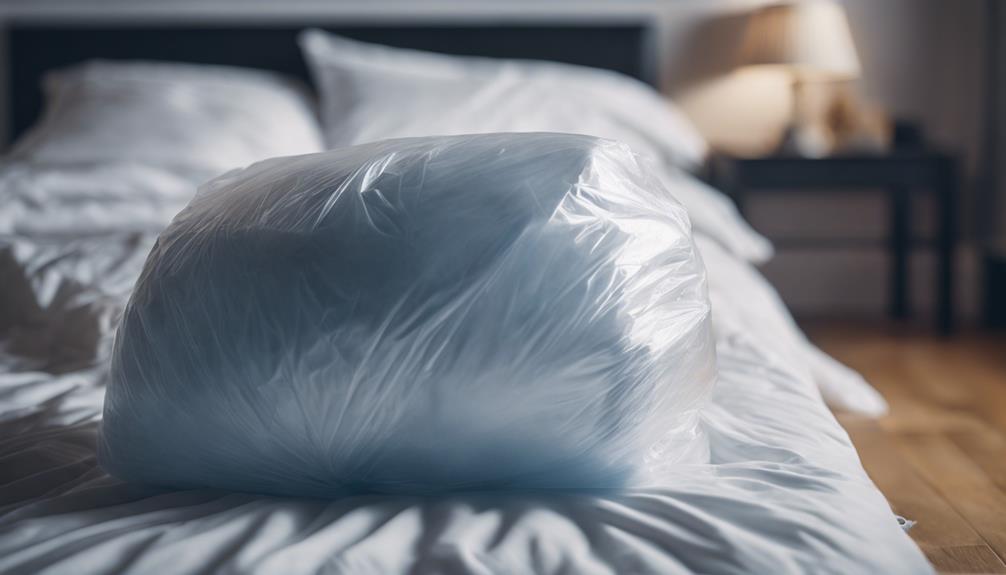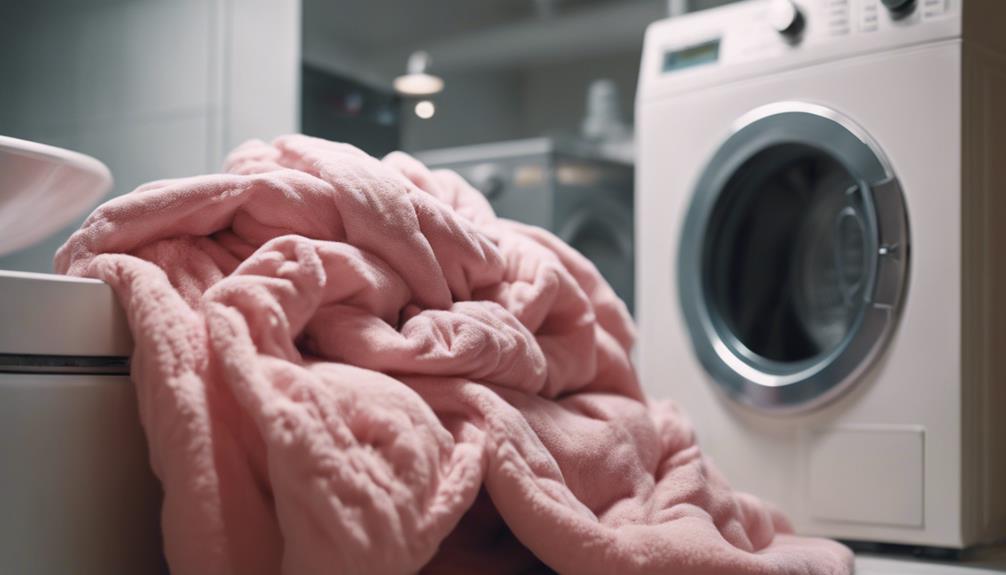When should you Begin Using a Comforter? Around 7-9 months is key. Babies tend to demonstrate signs of readiness at this stage, such as increased clinginess and separation anxiety. Introducing a comforter can help promote feelings of security, emotional well-being, self-soothing, and independent sleep habits. It is crucial for fostering healthy attachments. Remember to prioritize safety by selecting a safe and breathable option, and always supervise its use during sleep. To effectively introduce a comforter, start around 7 months, incorporate it into routines, and sleep with it to transfer your scent. These strategies will aid in forming positive associations. A proper introduction of a comforter benefits both babies and parents.
Key Takeaways
- Start introducing a comforter around 7-9 months when baby shows readiness signs.
- Choose a safe, breathable comforter to ensure baby's safety during use.
- Incorporate the comforter into feeding and wind-down routines for familiarity.
- Sleep with the comforter to transfer your scent, creating a comforting association for baby.
- Create peaceful sleep environments by using a comforter in bedtime routines.
Ideal Age for Introducing Comforter

Introducing a comforter to a baby is typically recommended around 9-12 months of age. At this stage, babies have usually developed the motor skills necessary to move the comforter around and manipulate it safely. Safety is paramount when it comes to introducing comforters to babies, especially during sleep times. It's vital to make certain that the comforter is securely attached to the crib or bassinet to prevent any risk of suffocation.
Before introducing a specific comforter toy, it may be helpful to start with a muslin square to create positive associations with feeding times. This can help the baby recognize the comforter as a source of comfort and security. While some babies may show interest in comforters earlier, it's generally recommended to wait until around 9 months old when they move to their own room.
Observing your baby's readiness and preferences is key in determining the right time to introduce a comforter for a safe and peaceful sleep environment.
Signs of Baby's Readiness

When babies show signs of seeking reassurance, demonstrating attachment behaviors, and seeking comfort, it indicates their readiness to start using a comforter around 7-9 months of age.
To determine if your baby is ready for a comforter, consider the following signs:
- Increased Clinginess: If your baby becomes more clingy or seeks more physical closeness with you, it may suggest a need for additional comfort and security.
- Separation Anxiety: Babies who exhibit heightened separation anxiety may benefit from the soothing presence of a comforter when you aren't around.
- Need for Soothing: If your baby seems to require more soothing or calming techniques to settle down, introducing a comforter could offer them the reassurance they seek.
- Attachment Behaviors: Babies who start to form a strong attachment to specific objects or people may find comfort in a soft and safe comforter.
Observing these behaviors can help you make an informed decision about introducing a comforter to support your baby's emotional well-being and provide a sense of security during their development.
Benefits of Using Comforter

Using a comforter can foster a sense of security and emotional well-being for babies, aiding in self-soothing and promoting independent sleep habits. Comforters play an essential role in a baby's bedtime routine by providing comfort and familiarity during sleep. They offer emotional soothing during changes and times of critical importance, helping babies manage their emotions effectively.
Babies can form healthy attachments to their comforter, which becomes a beloved sleep companion. This attachment can provide immense comfort and reassurance to babies, contributing to their overall well-being. By introducing a comforter into a baby's sleep environment, parents can support their child in developing self-soothing skills and establishing a positive association with bedtime.
The comforter becomes a source of comfort and security, aiding in creating a peaceful and restful sleep environment for babies to thrive and grow.
Safe Practices for Comforter Usage

To guarantee safe usage of comforters, it's important to select appropriate options that prioritize the baby's well-being and adhere to safety guidelines. When incorporating a comforter into your baby's routine, consider the following:
- Wait for the Right Age: Introduce a comforter when your baby is around 7-9 months old to make sure they're developmentally ready for this soft toy.
- Choose Wisely: Select a comforter that's safe to use, making certain it's breathable and free of small parts, ties, or batteries that could pose a risk.
- Supervise During Sleep: When allowing your baby to sleep with a comforter, ensure to supervise them to prevent any potential hazards like the comforter being wrapped around them.
- Incorporate into Routine: Incorporate the comforter into playtime and bedtime routines to help familiarize your baby with it and create positive associations.
Tips for Successful Comforter Introduction

One effective way to introduce a comforter successfully to your baby is by incorporating it into their daily routines from an early age. We recommend introducing a comforter around 7 months old when babies start seeking reassurance and comfort. It's important to choose a safe and breathable comforter to guarantee Safe Sleep practices. To help your baby form a positive sleep association with the comforter, try sleeping with it yourself to transfer your scent. Additionally, use the comforter during feeding times and wind-down routines to create a comforting association for your baby.
| Tips for Successful Comforter Introduction |
|---|
| Start around 7 months old |
| Choose safe and breathable comforter |
| Use during feeding and wind-down routines |
Frequently Asked Questions
When Should I Introduce a Comforter to My Baby?
Around 7-9 months, we should introduce a comforter to our baby when they seek reassurance and comfort. This is when babies develop a stronger sense of attachment and start showing interest in comfort items.
Waiting until around 7 months allows our baby to benefit from the emotional soothing and security a comforter provides. Early introduction helps babies learn to self-soothe and manage their emotions, making it an ideal time to start incorporating a comforter into our baby's routine.
Can a 1 Year Old Sleep With a Blanket?
Yes, a 1-year-old can safely sleep with a thin blanket after 18 months. Introducing a blanket too early can pose entanglement risks.
Ensuring the child's safety during sleep is essential. It's best to avoid soft bedding to prevent suffocation or entrapment.
Can My 2 Year Old Sleep With a Comforter?
Yes, a 2-year-old can sleep with a comforter as long as it meets safety standards. It should be small, breathable, and free of choking hazards. Supervision is essential to guarantee safe use during sleep.
Comforters can offer comfort and security to toddlers. It's important to follow guidelines to prevent risks.
Be cautious and choose age-appropriate bedding for your child's peaceful sleep.
When Should I Start Using Bedding?
When you should start using bedding depends on your child's age and safety guidelines. Experts suggest introducing bedding, like comforters, after 12 months. Waiting until at least 18 months before adding a blanket can help guarantee safe sleep practices.
It's essential to follow these recommendations to create a secure sleep environment for your little one. Safety is a top priority when introducing bedding to babies.
At What Age Should I Introduce a Comforter to My Child?
Introducing a comforter to your child at around 1 year old can help promote a sense of security and improve their sleep quality. The importance of comforters in sleep is evident in how they can soothe and comfort young children, making the transition to bedtime easier for both the child and the parent.
Conclusion
To sum up, introducing a comforter to your baby at the right age can bring numerous benefits and comfort. Remember to look out for signs of readiness and follow safe practices for usage.
By starting early, you can help your baby develop a sense of security and comfort that will last a lifetime.
So don't wait too long, get that comforter into your baby's life and watch them thrive in a world of cozy exaggeration!










